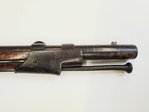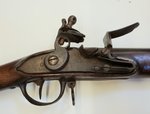

As the American Revolution began on April 19, 1775, and the alarm spread, men from all over New England marched towards the outskirts of Boston. They were armed with a variety of older military arms, civilian fowling/hunting guns, and whatever they could cobble together into a functional firearm. While the armies formed, the guns brought to the Siege of Boston rarely made it home as the army desperately needed them. The Provincial governments scrambled to setup arms manufacturing to help supply the army. But the army were not the only ones who needed arms. By law, all males from 16 to 60 had to be armed and equipped “according to law” for their service in the militia who would be needed to back up the army. Being secondary to the main army, this left the town militias in a precarious situation. The Continental and state governments began looking for outside sources of arms from other countries, and one who was secretly willing to supply arms were the French.
When George Washington took command of the fledgling Continental army in Cambridge on July 3, 1775, he began to take stock of his men and material for war. Desperate calls were made to the communities for guns but not many were available to send. As early as March 1776, French arms began to trickle into the colonies but not in large enough numbers to make a difference. One French supplier reached out to Massachusetts in October 1776 to let them know that he was readily able to supply whatever arms were needed and that he had already sent two ships to Providence, Rhode Island with war materials. The model of musket listed as “Being of the last made for the Infantry of France,” the Model 1763 musket.
To me, the French Model 1763/66 musket is not as pretty as the British arms of the period, but it was extremely functional and soldier friendly. Instead of the barrel being pinned to the stock, it had removable barrel bands to make it easier to clean and repair. It was fairly light, and had a .69 caliber bore, smaller than the British .75 caliber guns, and was available in large numbers.
Town selectmen had been writing to the Massachusetts Provincial Congress begging for arms and by the spring of 1777, large numbers of these muskets arrived in Portsmouth, New Hampshire and other ports not blockaded by British ships. In many cases, chests of gun locks also arrived to build into functional arms by local makers. As the Continental Army became better supplied, some of these arms were sold to towns to outfit and equip their militias.
Throughout the war, French and American ships brought tons of materials into this country, and this explains why so many of these arms are found. I see them at shows quite frequently, as well as small town museums and historical societies. I never really gave them much thought till I started to dig through town and state archives and finding more information. It’s a really interesting story and makes me appreciate these guns more than I ever did before.
Comments
No comments on this item Please log in to comment by clicking here